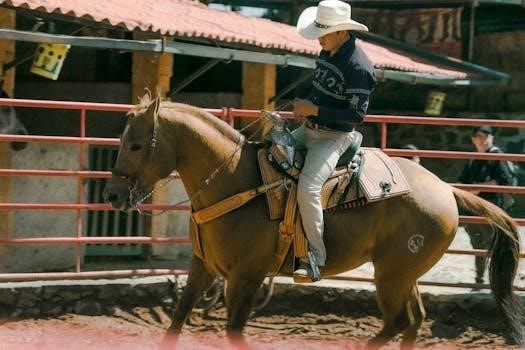Horse Bit Guide⁚ An Overview
Horse bits are essential tools for communication between rider and horse, influencing movement through pressure.
Selecting the right bit requires understanding bit mechanics,
various designs, and considering both horse sensitivity and rider experience for effective communication.
Horse bits are fundamental pieces of equipment used in riding and training, fitting into the horse’s mouth to provide control and communication. The bit exerts force inside the horse’s mouth, influencing behavior and movement when the rider applies pressure through the reins. Bits come in various shapes and designs, and what suits one horse won’t necessarily work for another.
Understanding how a bit functions is vital before using it. The basic families of bits are defined by whether they use leverage. The three main types of horse bits are snaffle, curb, and combination. However, there are many variations within each type.
Understanding Bit Mechanics
Understanding bit mechanics is crucial for effective communication. Bits apply pressure to specific points in the horse’s mouth.
Different bit designs and types affect these pressure points uniquely, influencing the horse’s response to the rider’s aids.
How Bits Work⁚ Pressure and Communication
Bits function by applying pressure to the horse’s mouth, tongue, and bars, facilitating communication between rider and horse.
The bit’s design determines where and how pressure is distributed, influencing the horse’s response.
Snaffle bits apply direct pressure, while curb bits utilize leverage.
Understanding these pressure points is crucial for effective and humane horsemanship.
A bit isn’t designed to control the horse, but to communicate the rider’s wishes.
The horse responds instinctively to the pressure on the bars of the mouth.
The bit works with the reins to apply this pressure, and in the case of curb bits, with the bridle.
The idea is that the bit applies subtle pressure to the bars of the mouth, which are made of sensitive cartilage.
Snaffle vs. Curb Bits⁚ Key Differences
The fundamental difference between snaffle and curb bits lies in their action and the pressure points they affect.
Snaffle bits apply direct pressure to the horse’s tongue, bars, and corners of the mouth.
Curb bits, however, utilize leverage via shanks, exerting pressure not only on the mouth but also on the poll and chin groove, often with the aid of a curb chain.
Snaffles are generally considered milder, promoting direct communication, while curb bits offer more control through increased pressure and leverage.
Snaffle bits use a bit ring at the bit mouthpiece to apply direct pressure.
Curb bits use a type of lever, called cheeks, instead of bit rings.

Types of Snaffle Bits
Snaffle bits are popular due to their mild action and simple design.
They apply direct pressure, offering various mouthpieces like single-jointed, twisted, or mullen mouth.
Different ring types further customize the bit’s action.
Common Snaffle Bit Designs and Their Uses
Snaffle bits, widely used in English riding, feature diverse designs catering to varying horse sensitivities and training levels.
The D-ring snaffle offers stability, while the O-ring snaffle provides quicker response.
Eggbutt snaffles prevent pinching, enhancing comfort.
Full cheek snaffles aid in steering, especially for young horses.
Mouthpieces range from single-jointed, applying tongue and bar pressure, to mullen mouth, offering gentler, even pressure.
Twisted mouthpieces increase severity.
Snaffles are selected based on the desired level of control and the horse’s responsiveness, making understanding these nuances crucial for effective communication.

Types of Curb Bits
Curb bits utilize leverage, employing shanks to apply pressure to the mouth, poll, and chin.
These bits offer increased control, often used in Western riding and advanced disciplines requiring nuanced communication and refined cues.
Understanding Leverage and Curb Chain Action
Curb bits function through leverage, using shanks to amplify rein pressure.
The curb chain or strap, positioned under the horse’s chin, plays a critical role in this mechanism.
When the reins are engaged, the shank rotates, tightening the curb chain.
This action applies pressure to the chin groove, poll (via the bridle), and the horse’s mouth.
The severity of the curb bit’s action is influenced by shank length, curb chain tightness, and rein pressure.
Longer shanks increase leverage, resulting in a stronger response.
A properly adjusted curb chain ensures even pressure distribution, preventing discomfort or injury.
Understanding these elements is essential for effective and humane use.
Pelham Bits⁚ A Specialized Curb Bit
Pelham bits offer a unique combination of snaffle and curb actions.
They feature a single mouthpiece with two rein attachments, allowing riders to apply direct and leverage pressure simultaneously.
A curb chain is used to enhance leverage.
The Pelham is used with two reins, or rein converters.
This design is versatile, making it suitable for horses that need a blend of control and responsiveness.
Pelhams are often seen in hunter disciplines.
They don’t apply pressure to the poll, making them suitable for sensitive horses.
Riders can choose between different mouthpieces, like the mullen.
The Pelham bit allows you to have both reins or use one.
Combination Bits
Combination bits merge the actions of snaffle and curb bits, offering nuanced control.
They often incorporate a hackamore with a mouthpiece.
These bits allow riders to influence different areas of the horse’s mouth and head.
Combining Snaffle and Curb Actions
Combination bits offer a unique approach by merging the direct pressure of a snaffle with the leverage action of a curb bit. These bits often feature a mouthpiece, such as a snaffle, combined with shanks and a curb chain or strap. This design allows the rider to engage different pressure points on the horse’s head, providing more nuanced communication.
The gag bit, frequently seen in English disciplines, exemplifies this combination. By integrating diverse mouthpieces and cheek pieces, riders can achieve a wide array of control options. Combination bits are typically employed at higher levels of riding, demanding a skilled and experienced rider.

Bit Components Explained
Understanding the various parts of a horse bit is crucial for effective communication. Key components include the mouthpiece, which comes in diverse materials and designs, and the cheeks, shanks, and rings, each with specific functionalities impacting control.
Mouthpiece Materials and Designs
The mouthpiece of a bit significantly impacts a horse’s comfort and response. Materials vary widely, including metal, rubber, and plastic, each affecting salivation and sensitivity. Metal mouthpieces can be plain or feature rollers of stainless steel and copper. For sensitive mouths, options include vulcanized rubber, apple-scented plastic, or sweet iron.
Designs range from straight bars to jointed versions, with or without ports. Ports are inverted U-shapes that offer tongue relief. The choice of material and design should prioritize the horse’s comfort, encouraging salivation and responsiveness to the rider’s cues. Different designs give control of the horse.
Cheeks, Shanks, and Rings⁚ Functionality
Cheeks, shanks, and rings are crucial components influencing bit action. Snaffle bits typically feature rings for direct pressure on the mouth. Curb bits utilize cheeks and shanks to apply leverage. Shank length affects control; longer shanks offer more leverage. The purchase, located above the mouthpiece, connects to the bridle and influences bit speed.
A short purchase reacts quickly, while a long purchase is slower. The curb chain, attached to the purchase, reduces poll pressure. These elements work together to facilitate communication between rider and horse, impacting pressure distribution and control. Each element influences the pressure applied.
Measuring for the Correct Bit Size
Accurate bit sizing is vital for horse comfort and performance; Methods include using a bit sizer, string, or calipers. A properly sized bit prevents pinching or rubbing, ensuring effective communication and control during rides.
Methods for Accurate Bit Sizing
Achieving the correct bit size is crucial for your horse’s comfort and your control. Several methods ensure accurate measurements. Ideally, use an old bit as a guide. If unavailable, a bit sizer offers a precise measurement by placing it in the horse’s mouth and noting the width.
Alternatively, use a string or dowel, marking the mouth’s sides and measuring the distance. For frequent measurements, calipers provide a quick, accurate solution.
If an exact size isn’t available, opt for a slightly larger bit and use bit guards to prevent pinching and ensure proper positioning.
Choosing the Right Bit
Selecting the correct bit involves considering horse sensitivity and rider experience. Begin with a milder bit and adjust if necessary. Prioritize proper fit to avoid discomfort or injury, ensuring effective communication and control.
Considering Horse Sensitivity and Rider Experience
When choosing a bit, consider both the horse’s sensitivity and the rider’s experience. A less experienced rider should start with a milder bit, like a snaffle, to avoid inadvertently causing discomfort or confusion. Observe your horse’s reactions to the bit; signs of resistance or discomfort indicate a need for adjustment. A sensitive horse may benefit from a bit made of softer materials like rubber or sweet iron.
Remember that communication is key, and the bit should facilitate a clear and gentle connection between horse and rider. Seek guidance from a trainer for tailored recommendations.

In-Hand Bits
In-hand bits are specifically designed for leading horses and should never be used while riding. These bits aid in training and control during ground work, ensuring safe handling and communication.
Bits Designed for Leading Horses
Certain bits are exclusively designed for leading horses in-hand, differing significantly from those used during riding. These in-hand bits prioritize control and communication from the ground, facilitating training and safe handling. They should never be used while riding.
These bits emphasize clear signals and responsiveness, helping the horse understand commands and maintain proper posture. Often, they incorporate features that encourage respect and attention from the horse, enhancing the handler’s ability to guide and direct.
Selecting the appropriate in-hand bit depends on the horse’s training level and temperament, ensuring a positive and productive ground work experience.















